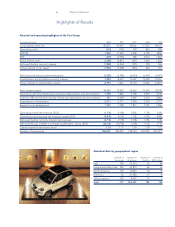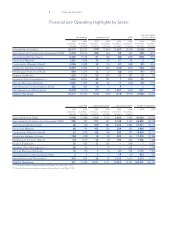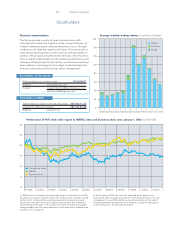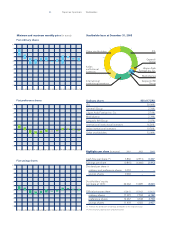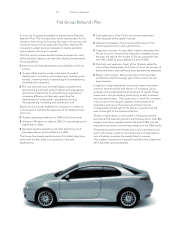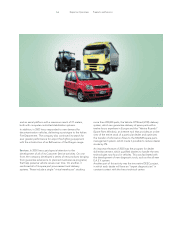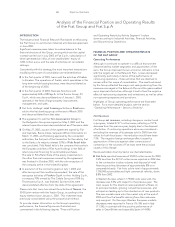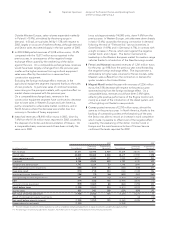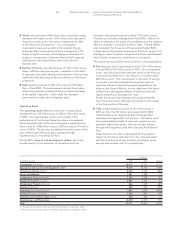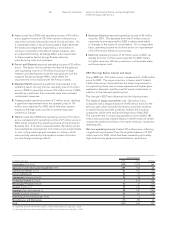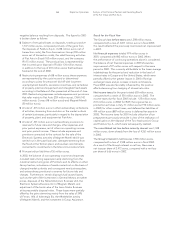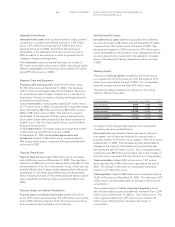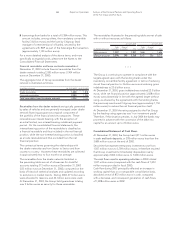Chrysler 2003 Annual Report Download - page 19
Download and view the complete annual report
Please find page 19 of the 2003 Chrysler annual report below. You can navigate through the pages in the report by either clicking on the pages listed below, or by using the keyword search tool below to find specific information within the annual report.
18 Report on Operations
At December 31, 2003, the Group had 162,237 employees,
compared with 186,492 at the end of 2002.
The Group hired approximately 11,500 new employees in
2003 — approximately 3,400 in Italy and approximately 8,100
in other countries.
A total of approximately 22,700 employees (10,200 in Italy
and 12,500 in other countries) left the Company.
Business acquisitions and disposals resulted in a net decrease
of 13,100 employees. The largest reductions stemmed from
the disposals of FiatAvio S.p.A., the Toro Assicurazioni Group,
Fraikin and Fidis Retail Italia.
Organizational and Management Changes
All Sectors continued to work on streamlining their
organizations and making them responsive to changes
in the business environment.
The priority specifically assigned to the deployment of
an effective corporate governance system resulted in the
establishment, at the senior management level, of an Internal
Audit Function by Fiat S.p.A. and the Group’s operating
companies.
The definition and implementation of the Group Relaunch Plan
required the strengthening of the Business Development and
Strategies Department and the establishment of a Corporate
Initiatives Function by Fiat S.p.A. Responsibilities similar to
those entrusted to the Corporate Initiatives Function were also
established at the Sector level.
An important chapter of the Relaunch Plan deals with the
strategic objective of increasing the Group’s competitiveness
by strengthening its management organization. In 2003, Fiat
S.p.A. and the Sector parent companies hired more than 90
management employees from outside the Group, including
seven who were selected to fill senior management positions.
In addition, the Group worked to enhance the value of its
management personnel by advancing to key positions executives
who showed that they possessed the requisite skill sets.
ENHANCING THE VALUE OF HUMAN RESOURCES
The high skill level possessed by the Group’s staff is
demonstrated by the large number of professionals it includes
(25,269 in total, 42% of whom work outside Italy).
Hiring Qualified Resources. In 2003, the Group hired a total of
about 400 recent college graduates. In addition, it was deeply
involved in the Automotive Engineering School at Turin’s
Politecnico University and provided support for its activities.
Students are expected to begin graduating from this specialized
degree program in 2004.
Leadership. The program used to assess and develop
leadership became operational in 2003. About 800 managers
participated in the assessment phase and were provided with
feedback about their leadership style.
Management Review. The development of internal resources is
ensured by the management review process. More than 7,000
employees have gone through this process, which is designed
to provide a quantitative and qualitative analysis of their
management skills.
People Satisfaction. The survey cycle launched in October 2002
was completed in 2003. Improvement programs based on this
survey are being implemented by the Sectors and operating
companies.
Professional Development and Training. In 2003, the Group
invested 95 million euros (2% of its total payroll) in training and
professional development programs designed to support the
operations of its companies around the world. About 71,000
employees received training and development support.
Isvor Fiat, which acts as the corporate university of the Fiat
Group, also offers its services to noncaptive clients. In 2003,
Isvor Fiat provided training, consulting and professional support
programs representing a total of 29,200 classroom days.
An additional 37,800 employees were enrolled in 340 courses
and received a total of 798,000 hours of distance- and open-
learning support.
Fiat Grants and Scholarships. The Fiat Grants and Scholarships
Program, which was created in 1996 and is available to the
children of active Group employees both in Italy and abroad,
is continuing with considerable success.
In 2003, Fiat awarded 545 grants, including 183 to students
in Italy and 362 to students in other countries (*), at a total cost
of 978,000 euros.
(*) Brazil, France, Poland, Spain and the United States.
INDUSTRIAL RELATIONS
Most of the activity in the area of industrial relations involved
managing the restructuring programs launched in 2002 and
updated in 2003 to make them consistent with the objectives
of the Fiat Group Relaunch Plan. Staff reductions were carried
out through the social shock-absorber programs available under
existing laws and through social impact plans, most of which
agreed with the unions, that cushion the impact of downsizing
measures on Group employees.
In Italy, Fiat Auto and certain Magneti Marelli and Comau
factories stopped using the “Cassa Integrazione Straordinaria”
(Special Temporary Layoff Benefits Fund) within the authorized
12-month period. A portion of the employees covered by the
Cassa Integrazione Straordinaria returned to work, except for
about 500 employees from the Fiat Auto plant in Arese for
whom the Ministry of Labor granted authorization to use the
Cassa Integrazione Straordinaria until December 31, 2004. The
remaining redundancies left the Companies under mobility
allowance, the so-called “mobilità di accompagnamento alla
pensione”, i.e. long-term unemployment benefit for workers
who are expected to reach retirement age during their mobility
benefit period.
Human Resources


